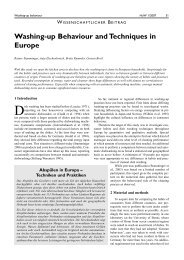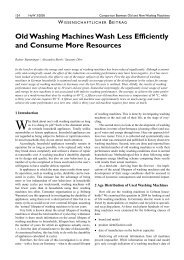Development of a novel mechatronic system for mechanical weed ...
Development of a novel mechatronic system for mechanical weed ...
Development of a novel mechatronic system for mechanical weed ...
You also want an ePaper? Increase the reach of your titles
YUMPU automatically turns print PDFs into web optimized ePapers that Google loves.
State <strong>of</strong> the art<br />
1998). This device consists <strong>of</strong> a 30 cm diameter rotating disk that rotates on an<br />
axis parallel to both the ground and direction <strong>of</strong> travel. Two knives, attached<br />
with springs opposite to each other on the perimeter <strong>of</strong> the disk, can stay<br />
retracted inside the disk area or they can fold out depending on the intensity <strong>of</strong><br />
the rotational speed, due to the balance between the centrifugal <strong>for</strong>ce and the<br />
spring <strong>for</strong>ce. The disk is actuated by a hydraulic motor whose exact rotational<br />
speed is controlled by a hydraulic controller. The controller adjusts the rotational<br />
speed value according to the detected plant position. The detection unit<br />
consists <strong>of</strong> a combination <strong>of</strong> three infrared transmitters and receivers placed<br />
above each other on a gantry on different plant height levels. A weighted<br />
summation <strong>of</strong> the signals from three sensors is combined to a single signal<br />
which is a base <strong>for</strong> processing.<br />
During the <strong>weed</strong>ing operation the motor rotates permanently at 850 rpm with<br />
knives extended to the working position, until the detection <strong>system</strong> does not<br />
detect a beet plant. After a beet has been recognised the rotational speed<br />
decreases to 700 rpm with almost immediate fold-in <strong>of</strong> the knives.<br />
At Cranfield University in Silsoe, UK, a rotating disk <strong>weed</strong>er has been<br />
developed (Dedousis et al. 2006). It consists <strong>of</strong> a thin rotating disc with a cut-out<br />
sector and a bevel cut back at its circumference (see Figures 2.5 and 2.6). The<br />
disc acts in a horizontal plane and operates at a fixed distance parallel to the<br />
plant row. This allows the disc to work the ground in both the intra- and inter-<br />
row areas. As the disk rotates, the <strong>weed</strong>s are cut by the sharp edge along the<br />
perimeter. The bevelled cut-out section allows <strong>for</strong> one plant per revolution to<br />
stay in the protected area without the contact with the disc. Assuming a plant<br />
distance <strong>of</strong> 300 mm, the ideal disc geometry was calculated to have a 175 mm<br />
diameter and 130° cut-out section. A bevel shape can be modified on the disk to<br />
achieve different kinds <strong>of</strong> <strong>weed</strong> cutting. Also, the inclination angle and working<br />
depth are adjustable depending on the plant type and soil conditions.<br />
Preliminary tests have shown that up to 60 % <strong>of</strong> <strong>weed</strong>s within an 80 mm radius<br />
can be eliminated, and up to 80% <strong>of</strong> <strong>weed</strong>s at greater radii. In a test in<br />
September 2006, 77 % <strong>of</strong> <strong>weed</strong>s were judged to be removed and only one plant<br />
out <strong>of</strong> 24 showed damage. Angular error <strong>of</strong> the disc was also quite low,<br />
normally less than 10°. A disadvantage <strong>of</strong> this tool is that it is limited to plant<br />
24





